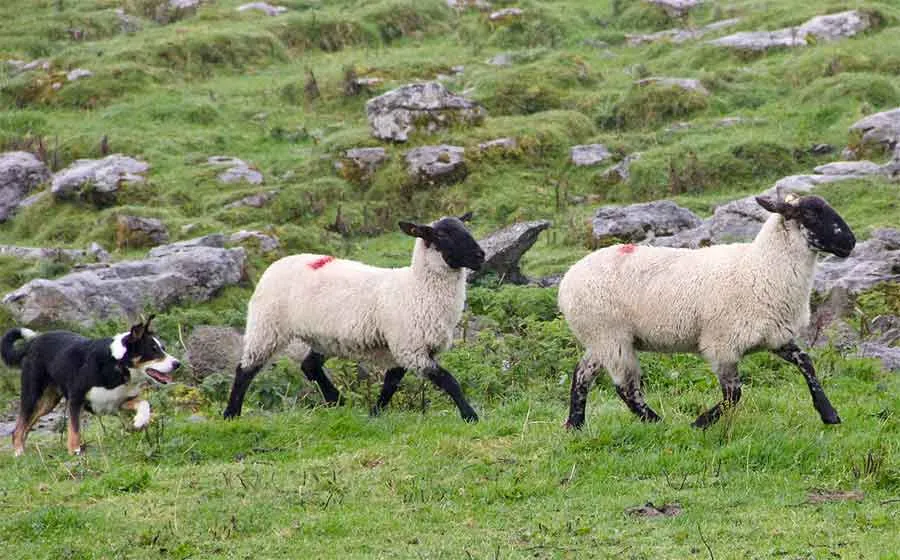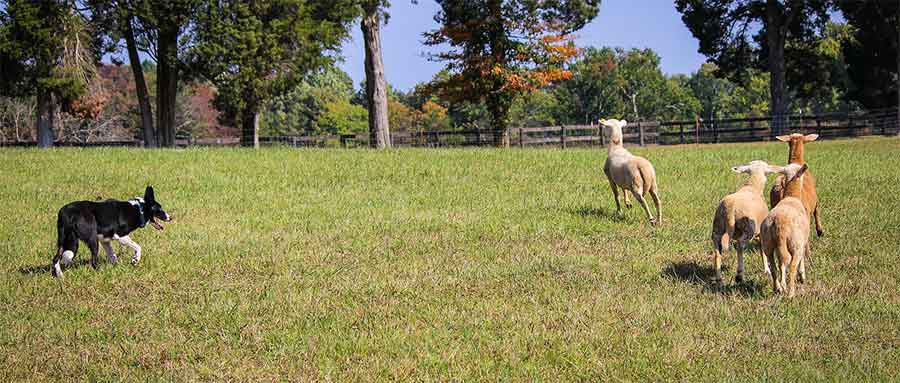Does Your Dog Chase Livestock?

Dogs have many behaviours that are instinctive rather than learned. These instinctive behaviours are inherited from their ancient ancestors such as wolves and other feral canines, and sometimes appear to make no sense in the modern world of pet dogs. All dog owners will have noticed some of them in our own pets; circling before lying down to rest (treading down the grass/ferns), burying bones or toys (making a cache of food for future lean times), peeing small amounts in various places (marking and therefore protecting territory from an invading pack), chasing a toy/ball and bringing it back to their human pack, or sometimes just deciding to keep it like a trophy!
This last one, seeking and chasing and bringing back, derives from the instinct to find, chase and catch prey to sustain themselves and/or their pack. Humans have managed to harness and employ this instinct to their advantage in some breeds. There are the amazing Border Collie sheep dogs helping their owners, Pointers who hunt with their nose and eyes to flush out birds and rabbits, silently showing their owners where they are, Spaniels and Retrievers who find the felled birds or rabbits and gently carry them back for their owners. There are also the Terriers and sight hounds used for catching and killing rats and other small mammals in farmers’ barns and fields and often now in infested urban gardens.
Whilst the instinct to seek and chase has been harnessed and refined in some breeds, it is important to remember that ANY dog, regardless of breed, could switch from mild curiosity about the strange creatures in that field into full-on chase mode. Seeing them panic, bunch together and start to run in fear only adds to the thrill of the chase and could result in a dog catching and injuring or killing them.
A dog who loves to chase sheep is a serious liability for its owners. It is a situation that can be very harrowing for owners as they attempt in vain to get back control of their dog. It really is one of the most dangerous situations for a dog in the countryside. The law in the UK is very strict and ANY dog that is considered “out of control” can be seized, owners prosecuted and, ultimately, the dog may be euthanised. Furthermore, farmers are within their legal rights to shoot any dog seen to be worrying or harassing their stock.
Before you let your dog off-lead in the countryside, where there is a likelihood of livestock, you must be sure that your dog is under your control and unlikely to take matters into his own hands. However, even for owners who have great recall on their normal walks, the thrill of chasing sheep can sometimes override the training as adrenaline makes him deaf to your commands. In most cases, domestic dogs will not be looking to inflict harm, but a farmer cannot leave it to chance.
You would be well advised to keep your dog on a lead or a long line to ensure that you retain control whilst walking in these areas until you are 100% confident that your dog will always respond to your command. Read our training tips below.
It is not only livestock that is susceptible to a dog’s ‘prey’ drive. Many dogs will also chase cats, cars, joggers and horses being ridden along bridle paths. This behaviour could result in them biting a person, causing injury to a horse or its rider, or injuring itself and/or its owner. There are also cases of dogs catching and killing other small dogs, possibly mistaking them for prey, or where adrenaline kicks in and the attacking dog cannot stop himself.
Once an owner has recognised this behaviour, often after an upsetting incident, and has been unable to control or retrain their dog around what triggers the chase instinct, we, as behaviour therapists, are often asked to help. We have been successful in providing the owners with the techniques that will enable them to ensure the safety of people, animals and of course their dog! It does take commitment, time and consistent daily work, by the owners. A dog will always have the instincts but, with enough work, his respect and desire to please its owner can give control back to the owner and save the distress caused by an out-of-control, chasing dog. Owners who aren’t ready to make this commitment must understand that they should NEVER let their dogs off lead in certain areas.

What to do
Can you stop your dog when running off or chasing something, then recall them? A dog without perfect stop and recall is potentially an unsafe dog.
- Remember, you are setting your dog up to succeed, not fail, so plan your training carefully. Do recall exercises 2 or 3 times each day, gradually increasing the difficulty of the challenge once you are sure your dog is responding. If your dog starts to fail, go back a few steps to rebuild again, but always finish on a successful exercise.
- Start work in your house or garden i.e. in an area that doesn’t have major distractions.
- You can use high value food treats or, if your dog is ball or toy orientated, use these as well as or instead of the treats.
- Choose a word that means “stop” that you will use in a disapproving tone and a different recall word that must be used in a happy excited tone to call your dog. You may have to practice changing tone! Be consistent in the use of the words and tone.
- First ensure that your dog has a solid sit/stay, then move on to providing a distraction of a moving treat or toy. Face your dog and drop the treat/toy behind you watching your dog, stopping him from getting it. Don’t use physical methods, like bending down to grab or guide, this will reduce your effectiveness, use confident, assertive body language and voice.
- You may have to start with your dog on a long lead, to prevent him getting the item, to help him to learn.
- Once he has mastered the first stage, start to walk him on a lead past a tasty treat or toy teaching him to focus on you and not the treat/toy. Keep your lead loose, use your voice, only resorting to using the lead if your dog lunges towards the item.
- The next step is to start throwing the toy or other item as part of a game, without any commands. If your dog starts to chase, call out your STOP word, and by now he should listen to you and stop. Then use your happy, excited voice to call him back for huge hugs/fusses and praise. A long 20ft (7 meter) lead can help with this stage.
- So that you don’t spoil the game for him, also teach a “fetch it” phrase, so you can tell him when it is safe to go to find the item.
- Randomly, change from stopping him to sending him. Gun dogs are trained to stop/go so why not try it with your dog?
- Once you can recall him off lead past the treat/toy and stop him from grabbing it you are on your way!
- Once you are happy you have control in your home and garden, start working off-lead in a safe field or enclosed area away from livestock, ensure that you can always stop and recall your dog before moving on.
- Take him on lead near livestock, if he starts to pay attention to them, use your STOP command, then praise when he looks at you. Keep him focused on you by doing lead exercises, with lots of encouragement and praise. Don’t try to make him concentrate for too long as you may start to lose his focus. Keep it short and successful.
- If you live near livestock, ensure that your garden is well fenced to prevent escape.
Whilst we cannot give you a full training guide here, we hope that we have managed to stress the importance of having your dog’s ‘chase’ instinct under control for the safety of all countryside users, animals and or course your dog. If you are in any doubt about your abilities to train your dog out of this behaviour, call in a professional trainer to help you and, in the meantime, enjoy your country walks with your dog strictly on a lead.
Recent Articles
- Easter Holidays - Keeping our dogs safe around food
- Horticultural Horrors for Hounds
- Understanding Dog Body Language
- Heatstroke in dogs - know the signs and what to do
- Preventing Separation Anxiety When Returning To Work
- Separation Anxiety
- Managing your time at home with your dog
- Top 10 Indoor Games for your Dog
- Working from home with your dog
- COVID-19 Social Distancing and Self Isolation
